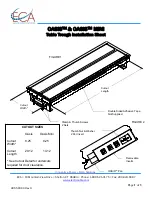
1
EM Technical Note
Date:
September 20, 2005
Author: Erik
Hammerstad
Subject: Sound Levels from Kongsberg Multibeams
The power output level of an echo sounder is normally specified by giving
its source level in dB relative to 1
μ
Pa at a distance of 1 m from the
transmit transducer. However this is really a measure of the pressure
level of the output sound wave and is only directly applicable in the
farfield. The intensity (power per unit area) of a sound wave can be found
from the pressure level by the relation I = p
2
/ c where is the water
density and c the speed of sound. The quantity c is the acoustic
impedance of water and for sea water is nominally taken to be 1.5x10
6
kg/m
2
s
.
Thus a pressure level in sea water of 1
μ
Pa is nominally equal to
an energy intensity of 0.667x10
-18
W/m
2
, and a pressure level of for
example 210 dB corresponds to an intensity of 667 W/m
2
.
In the farfield the pressure level of a sound wave will fall off with the
square of the distance, this because of spherical spreading of the wave,
and the wave will be further attenuated due to absorption loss. In the
nearfield the pressure level will be nominally constant as there is no
spreading. If the transmit transducer generating the sound wave is
rectangular, there will be a transition region in which the pressure will
fall of proportionally to the distance due to cylindrical spreading in the
direction parallel to the shortest side of the transducer. It may be noted
that in the nearfield the pressure level will have large variations, with
peaks up to about twice the nominal level and also deep nulls, this effect
will however be ignored in this note.
The source level is given by SL = 170.8 + 10lgP
Ac
+ DI. P
Ac
is the acoustic
power which is typically half the electric power applied to the transmit
transducer. DI is the transducer’s directivity index which for a rectangular
flat transducer can be approximated by DI = 46.2 – 10lg
x y
where
x
and
y
are the transmit beamwidths in degrees along and across respectively.
The relation between beamwidth and transducer array length, L, depends
upon the applied shading and the number of elements in the array,
typically it would be = 65 /L where is the wavelength. The nearfield
limit is conventionally given by R = L
2
/ .
To derive the pressure levels in the nearfield from the source level of an
echo sounder one must first calculate the pressure level at the largest
farfield limit assuming spherical spreading from the 1 meter reference
level used in defining the source level. From the largest to the smallest
nearfield limit the pressure level will increase linearly with distance, and





















